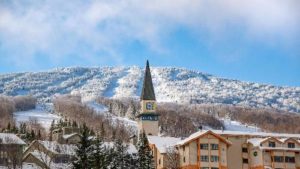
Border War! Vermont vs. New Hampshire Skiing Part 7 – Stratton Mountain
—by Jay Flemma
Special to Slave to the Traffic Light Adventure Magazine.
This is the seventh piece in the VT vs. NH series.
Links to the rest are below—
STRATTON MOUNTAIN, WINDHAM COUNTY, VT – You should have heard the trash talking that went on about Stratton Mountain in the two years we’ve been working on this series. The Vermonters like to ruthlessly troll the New Hampshire folks. And the New Hampshirites love to crush the Vermonters right back. But everybody on both sides of the border – Vermont especially – saved their worst bile for Stratton.
“The Pumpkin Spiced Latte of Ski Resorts,” “Flatton,” and, worst of all “There’s a reason their mascot is a teddy bear. It’s just not that challenging” – those were just some of the antecedents Stratton absorbed before I rolled in for a weekend in late February. And as if that wasn’t enough, on the very eve of my trip, one Internet winter sports publication opened their review of Stratton with the most left-handed compliment I’ve ever seen:
“Stratton Mountain is a long established southern Vermont resort with a cosmopolitan atmosphere that’s rarely found in New England, a good illustration of the fact is the selection of quality French champagne stocked in the resort’s general store.”
First reaction: That’s your lede?
That same article contained nine long paragraphs about the food and nightlife options, but only one on the mountain’s terrain.
How could this possibly be? It’s not like Stratton is a pushover, is it? World Cup events have been held there – important ones in American skiing history. The Stratton Mountain School is one of the most prestigious in the country, producing over 100 members of the U.S. National Teams and dozens of Olympians over many generations, like Alice Merryweather, Lindsey Jacobellis, and Heidi Voelker. And this was where Jake Burton himself hiked the mountain in the dark of night to test his snowboard prototypes. So, why this disconnect? It seemed the first question I had to answer was “Does Stratton deserve to be distilled down to such vagueries as “heated cobble-stone pedestrian mall,” “smooth corporate image,” and “unrivalled designer stores?”
ANSWER: RESOUNDING NO.
All the haters can take their pumpkin spiced latte, their halibut rossini, and their Chateau Front de Boeuf, and down them with a nice, hot cup of shut the hell up, because Stratton was everything a skier could ask a big east coast mountain to be: brilliantly conditioned for all levels, an ergonomic mountain plan, a wide variety of terrain, including significant advanced and expert terrain, ferocious moguls, (my personal favorite), an all but unparalleled instruction team, incomparable history, and yes Рif you need them Рa dazzling galaxy of apr̬s diversions.
MOUNTAIN GAZETTEER
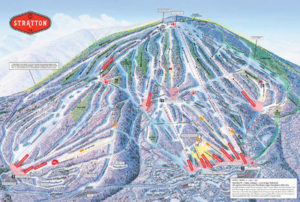
Stratton has 99 trails spread over 670 acres serviced by 11 modern lifts, but there are a few more important statistics than those. With 1,200 snow guns and a 220 million gallon water reserve, Stratton has 95% snow coverage.
Those are whopping numbers for the east coast. When you’re at lat/lon 43 degrees 7 minutes North, 72 degrees 54 minutes West of Prime, it’s a dicey proposition getting the natural coverage you need without significant snowmaking. Just look at what happened to Haystack…err…Hermitage for a prime example of how warm winters can decimate a southern Vermont mountain. Similarly, Stratton averages a rather meek average annual snowfall of 15 feet. They often get that in a month at Whiteface.
But if there are two things that Intra West Company (the prior owners) and now Alterra did right, one of them was to concentrate on excellent snowmaking all across the mountain. That’s why Stratton thrives while other southern Vermont and western Massachusetts resorts merely survive. Improved snowmaking may not be as sexy as a new lift, a multi-million dollar lodge, or a new terrain park, but the consistently excellent snow attracts repeat business.
Consistently upgrading lifts is the second thing Stratton gets right. They can move a staggering 33,928 people up the mountain in one hour. That’s almost as many people as can fit in Fenway Park for a ball game (37,731). Or, if you prefer a skiing analogy, Arapahoe Basin, which is twice the acreage of Stratton, can only move 11,300 people per hour. Better still the lifts are cleverly located to spread guests all across the mountain. [Author’s Note: Let’s hope that the Covid-19 crisis only lasts one winter, as reports from the industry indicate only a tiny fraction of that number will be allowed to get lift tickets. And we mean tiny fraction…]
Looking down from the summit (3,875 feet above sea level and 2,003 feet above the base lodge), four lifts access the mountain’s peak, each from a different direction: the 10-seater gondola, (which starts at the base lodge), the 6-seat Shooting Star chair, the 6-seat Ursa Express, and the Snow Bowl Quad. There are over a dozen trails descending from the summit – everything from beginner to double black diamond – so everyone can ride the gondola to the top and find a way back to either the base lodge or any other part of the mountain they wish to explore.
The greatest variety of terrain off the summit is found on the Snow Bowl side, the north face of the mountain. Experts love to lap the Snow Bowl, alternating between Upper and Lower Spruce and Upper and Lower Slalom Glade. Both feature several hair-raising twists and fearsome headwalls.
“They’re great for a rip,” said a pretty young blonde in HH gear and a Jeremy Jones board, whose name we didn’t catch. “World Cup too, you can really fly down those,” and she’s right. Spruce was a rumbling rollercoaster, and World Cup was diamond hard ice, perfect for a race course. Meanwhile Drifter, Meadow, and Janeway Junction offer tamer rides, though no less beautiful, with Bromley staring back at you in the distance.
Oh…and then there’s Dino’s Drop, but we’ll get to that in a moment…
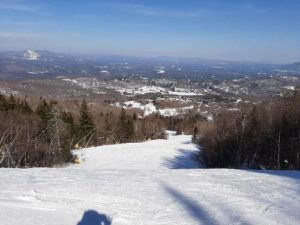
The gondola is just east of the Snow Bowl, and its lift line, Upper and Lower Standard, is one of two uber-wide supertrails at Stratton. With its top half rated expert and its lower half intermediate, it features switchbacks to access the mid-mountain lodge and eastern side of the mountain, or the Snow Bowl.
East of the gondola there’s more black diamonds than you’ll find on 46th Street in Manhattan. Using the Ursa 6 as your ride, you can lap narrow, twisting, quintessentially Strattonian runs like Grizzly Bear, Polar Bear, Upper Tamarack, and Frankie’s Fall Line, (the premiere race course on the mountain, named after Stratton founder Frank Snyder and the site of a competition during Your Author’s visit). Finally, mid-way up the east side of the mountain is the Shooting Star 6. Best of all, no matter which of these four lifts you take, you can access the other three from the summit.
The Shooting Star and Sunrise side also feature Kidderbrook, the longest trail at Stratton and the Beardown, the mountain’s fiercest mogul field. Ah yes, the Beardown: headwall after headwall after headwall, each steeper and longer than the last, and everything covered in moguls the size of Volkswagon Beetles. The moguls get bigger and more ferocious the further you go.
“You know a trail is iconic when people refer to it with the definitive article,” said our mystery girl on the JJ board. “The Beardown! It even sounds sinister,” she jibed.
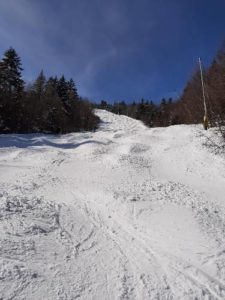
At the base of the east side, you’ll find the Sun bowl lodge and the Sunrise 6 servicing the Sunrise Supertrail and over a dozen trails more. One of them, Rowley’s Run, comprises the second half of the lift line and is an intermediate trail in name only. Only one or two turns wide on either side of the chairlift poles, one side is significantly higher than the other, making for tight turning in whichever lane you ski, but also a thrilling ride and a chance to show the folks on the chair how to handle the bumps. Hands in front, weight forward, knees flexing and extending, and bouncing off them like a pinball, smiling all the time: the crowd on the chair goes wild.
Rowley’s is the exception, not the rule when it comes to the trail map. Generally, everything is just a little easier than the map reads, but that’s good for patrons’ confidence. Expert skiers are wrong to dismiss Stratton as too easy for that reason alone. Just like sometimes a bogey golfer with the right kind of eyes can appreciate the strategic nuances of a golf course better that a seasoned touring professional, (because the expert player gets tunnel vision, looking only at the middle of the fairway and the pin). Similarly, perhaps the highest level skiers take Stratton underestimate the excitement factor that the rank and file skier/boarder experiences. And besides, everything depends on weather and conditioning. Hit up Stratton after a winter storm rages past and then see if it’s Flatton.
“Stratton has also significantly expanded its glade skiing in recent years,” explained Stratton instructor Iseult Devlin, who has taught at the mountain for 10 years. “Stratton was always known for its impeccable grooming, but its reputation for tree skiing is growing. There are even some secret stashes hard to find unless you know a local.”
There’s the most fun aspect of Stratton and of skiing in general – making friends with your fellow skiers. It pays dividends in powder and in getting a chance to learn the mountain’s precious secrets.
And finally, instruction at the mountain may be, arguably, the best of its kind in the country. Ever since the days of the Innsbruck Trio – the first instructors at the resort and who ultimately became known as the Stratton Mountain Boys – teaching has been not only a raison d’etre of Stratton and a source of justifiable pride, but a pinnacle they do not want to cede to anyone else. Now 60 years later, the nearby Stratton Mountain School, started in 1972 by families whose kids didn’t want to leave the mountain on Sunday nights, routinely sees its alumni become American skiing royalty. Jessie Diggens won America’s first medal in a Nordic event in 2018. Snowboarder Ross Powers won bronze in ’98 at Nagano and gold in 2002 in Salt Lake. And Alice Merryweather looks every bit the heir apparent to Mikaela Shiffrin as America’s top female racer. Academics are certainly not secondary as many graduates matriculate to Williams, Dartmouth, Harvard and Middlebury.
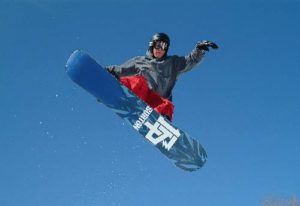
Of course on-mountain food is a bugaboo, like it is pretty much everywhere else. The much ballyhooed “vintage diner and BBQ” was overpriced and under-seasoned. And the rest was just more heavy, meaty, cheesy, bread-y, coma-inducing calorie bombs. You need chili to warm up? Who wants that gurgling in their stomach all day when you’re locking horns with a nasty double black diamond? As my Uncle Stanley always advised, “Don’t fart in your snowsuit, you’ll die.”
RIDE FOR JAKE

Of course, you can’t talk about Stratton without honoring Jake Burton Carpenter. Jake rightfully deserves to be considered as one of the mountain’s immortals, every bit as much as founder Frank Snyder, Emil Heinrich, the first ski school director, Steve and Phil Mahre who won events in the first World Cup races held in the American east in 1978, and even Hubert Schribl, the Himalayan mapper and long-time Stratton photographer. (“If Hubert didn’t photograph it, it probably didn’t happen!” is a rallying cry at the mountain.)
Lots of resorts try to claim that they founded or at least embraced snowboarding first, but because of Jake Burton, Stratton can claim rightful ownership or at least a huge chunk thereof. They looked the other way, secretly cheering, when Jake hiked up Suntanner in the dark of night to demo test his boards. They embraced snowboarding on the mountain in 1983, long before many other big-ticket resorts. And they opened the Jake Burton snowboarding school shortly thereafter.
Jake Burton changed the face of winter sports forever with more than just scientific genius. He had a combination of unquenchable spirit, a personality that brought the sun with him wherever he went, and yes, movie star good looks. And he did it from little ol’ Stratton, Vermont. And so it was that when Jake passed from cancer in November of 2019, Stratton led the winter sports world in memorializing him.
“We were devastated when we found out, and we immediately wanted…needed to do something meaningful,” recalled Myra Foster, senior manager of marketing and communications at Stratton. “We wanted whatever we did to acknowledge what he and his work meant not just to Stratton, but to mountain enthusiasts all over the world.”
So on Saturday November 22, the opening day of the 2019 season, a lone chair, empty except for one of Jake’s original Backhill boards, led everyone up the mountain. Then at the end of the day everyone gathered at the summit – hundreds and hundreds of skiers and boarders, many shedding a poignant tear – to take “The Run for Jake.”
“We started on Upper Standard, and then each went our separate ways, although many ended up finishing the run by coming down Suntanner,” Foster concluded.
Afterwards, Phil Scott, the governor of Vermont, proclaimed November 22 “Jake Burton Day” at Stratton, and a plaque was raised in Jake’s honor at the top of Suntanner, where it all began. Honor well deserved. No trip to Stratton is complete without paying homage to Jake by stopping by to touch the plaque and ride down Suntanner in his memory.
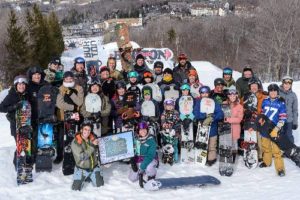
HEY STRATTON HATERS: LOOK AT THE SCOREBOARD
When you look at magazine rankings Stratton perennially scores in the top 10 for snow, grooming, lifts, terrain, instruction, and (insert laundry list of what I call “intangibles,” a.k.a. après…).
“Yes, but they rarely win,” said one detractor. “They’re like the Netherlands in soccer. The Dutch win a lot of games, but not a lot of trophies. It’s the same for Stratton. They place and show, but rarely take the top spot.”
Maybe, but what Stratton may lack in depth in any one particular category, they more than make up for in breadth, and that’s what’s helped breed generation after generation of success. That is another hallmark of Stratton. Families come here year after year.
“We skied there as grommets, my brother and I. Our family would go for a weekend or even for a whole week,” beamed Kathleen Buckley, an effervescent brunette with almond-shaped brown eyes and a sweet smile as she recalled the fond memories. “We’d get a chalet right on the mountain and ski to the lifts. We even celebrated Christmas there. Now, a generation later, we’re bringing the newer members of the family. Stratton is part of our circle of life.”
So as they said in the old game show, will the real Stratton please stand up? At Stratton oenophiles and foodies sleep cheek and jowl with snowboarding bros, (when they’re not anti-social distancing that is). It’s a riddle wrapped in a mystery inside an enigma…or maybe our sport is more tolerant and inclusive than people give us credit for. Being so close to NYC and Boston, Your Author saw families of all walks of life enjoying the slopes together – Black, White, Asian, Latino – everyone welcoming each other: strangers stopping strangers just to shake their hand. It was just how Frank or Jake or Hubert or Emil or the Mahres would have wanted it.
SORRY, DINO, IT’S JAY’S DROP NOW
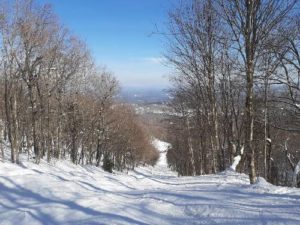
There was one epic Stratton moment that Hubert Schribl’s eagle-eye camera lens didn’t capture. Don’t look for it on ESPN.com or any YouTube videos. You won’t catch it at Teton Gravity or the latest Warren Miller film. It might not be as historic as Phil or Steve Mahre’s World Cup winning runs or Jake Burton’s midnight sojourns or even some highlight reel from the X games, but this run was white-knuckle, hair-raising, adrenaline pumping, sheer terror. And it belongs to Yours Truly, Your Author, who chased his cell phone nearly all the way from trail entrance to chairlift after dropping it down the headwall of something colorfully called “Dino’s Drop.”
Heavy emphasis on “drop…”
Criminally narrow, tree-lined on both sides, steeply pitched, and an unending minefield of unexploded moguls, Dino’s…err…Jay’s Drop was my personal playground and serious aerobic workout for much of the weekend. An old poma lift-turned thrill ride, I took new friends and old down it, and everyone said the same thing at the finish: “I’m sweating. That was tough.”
I’d smile and say, “Yeah! Let’s go again!”
I didn’t get much repeat business…
Still, Jay’s Drop was so idyllic, so gorgeous, so drenched in precious solitude, that late in the day, while cruising the moguls alone, I stopped to take a picture…
…and dropped the cell phone…hence “Jay’s Drop.”
Instantly, there’s my cell phone racing down the headwall, hitting a mogul, soaring into the air, deftly doing a 720 and sticking the landing like Jeremy Jones, before continuing down at breakneck speed headlong towards oblivion, my entire contacts list with it.
I have enough time to snarl, “Oh you freaking Jerry…” as I hurtle pell-mell straight down after it, and moguls be damned.
For one run, Johnny Mosely had nothing on me.
I pinball off the moguls, finally getting within reach of the phone when – NO! – it bounces off the next bump just out of reach. I get just within a ski pole’s length again when LOOK OUT FOR THAT MOGUL!!! WHOA!
Miraculous save! I’m still on my feet! There’s the phone…I’m catching up…and then…HEADWALL!
Down we go together! The phone disappearing and reappearing and me scanning for the phone and just reacting to the moguls, mortally terrified, I won’t lie. Then, suddenly, the phone comes to a screeching halt, its butt end sticking halfway out of a puffy mogul.
I catch it. I dust it off. It still works! I put it in my pocket, and as I start to breathe a sigh of relief I realize…where are my gloves?
With a sinking feeling I look up not one but three headwalls. There they were, all the way at the top, right where I dropped them in my panic.
I think they winked at me. Bawdily.
I get about two sidesteps up before realizing I have no chance. And so, skis off now, I start climbing like Conrad Anker up the headwalls to fetch them.
Still, that was one hell of a run. They say necessity is the mother of invention, but I guess it’s also the mother of talent. Dive in and swim! I went from Jerry to Champ is 15 seconds flat. But then again, that’s skiing – there’s a little of both of those in everybody. Or maybe Stratton just tends to bring that out in us.
Quality of Snow/Grooming – 9.5
Variety of Terrain – 9.25
Lifts – 9.5
Snow coverage – 9.75
Natural Setting – 8.75
Kid/Family Friendly – 9.5
Character – 9.25
Challenge – 9.25
Dining on Mountain/Base Lodge – 7.5
Overall – 9.139
STRATTON MOUNTAIN RESORT GOLF COURSES
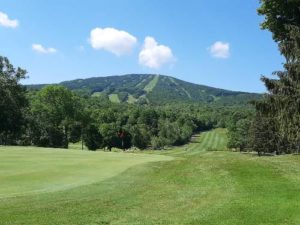
If you come to Stratton in the summer to play golf, cue up Toto’s “Africa,” Men at Work’s “Down Under,” and “Escape: the Pina Colada Song” on your cell phone play list, because every day is ’80s day at the golf courses.
At least that’s what it feels like on many tee boxes.
The story of Stratton’s golf courses actually begins in 1964 with 18 holes designed by Geoffrey Cornish, a prolific northeastern golf architect responsible for several resort golf courses, including nearby Mount Snow. Called the Lake and Mountain nines, the courses enjoyed a day in the sun a generation ago; from 1990-1995, they hosted an LPGA event, originally the Stratton Mountain Classic and later the McCall’s classic, sponsored the magazine of the same name. Popular LPGA star-turned NBC broadcaster Dottie Pepper won the final event, though the tournament was trimmed to 54 holes instead of the normal 72 due to inclement weather. Cornish returned to Stratton in the mid-1980s to build an encore, the Forest nine.
But Cornish was trained by Robert Trent Jones, Sr., and all 27 holes at Stratton were built during the “harder is better” craze that plagued golf design from 1940-1994. As such, the course is almost exclusively penal target golf. That makes for an exciting golf tournament, but less fun to actually go out and play. There are several ramrod straight holes, with penalties lurking on both sides. In several places, you’re forced to club down off the tee, either by creeks that cross the fairway perpendicularly or because the fairway is choked by trees on one side and water on the other. On such holes, the playing corridors are as wide as the actual fairway, and with hardwoods looming or water lurking, a missed fairway risks a likely unplayable lie or, worse still, a lost ball. It’s a penalty stroke either way.

Target golf went out of vogue a long time ago; it’s been 15 years at least. The Second Golden Age of Golf Course Architecture began in 1994, and gained national mainstream recognition around 2005, about the time the USGA started changing the way they set up U.S. Open courses. Public golf has especially benefited: Bandon Dunes, Streamsong, and Tobacco Road are just some of the instant classics that forever changed the shape of American public golf. The sport has conclusively moved away from target layouts and penal architecture.
Stratton’s courses are pretty, I’ll give Cornish that. There’s something absolutely primal about the first tee of all three courses, something even the most seasoned veteran and well-traveled golfer will still marvel at and appreciate. It’s one thing for a ski area golf course to let you see a trail or two as you make your way around the golf course. But at Stratton, the entire face of the mountain stands sentinel over you. You can stand on the tee and recite the trails as though reading the map: “Standard…Spruce…Lift Line…Slalom…” (or “Standard…Frankie’s…Tamarack…Grizzly Bear,” if you prefer…).
Bravo, Geoffrey! In golf parlance that’s called “statement of place.” What that means it the golf course’s identity should reveal itself from the get-go. It does at Stratton, in grand fashion.
Sadly, though, instead of a launching pad for the rest of the round, that’s where the best of Stratton golf ends. The par-3s are a particular weakness. At four of the six par-3s, you can’t see the putting surface. That works once, perhaps, if executed properly, but not four times. Besides, par-3s are your best chance to produce both a postcard photo and a strategic marvel. Stratton’s par-3s underwhelm both aesthetically and strategically.
The par-5s are a mixed bag. Three holes – five and eight on the Forest course and five on the Mountain nine – are simply a game of golf hopscotch as you play over forced carries from island fairway to island fairway with no strategic option to offer risk-reward. That’s ’80s all right, Weird Al Yankovic-type ’80s. The other par-5s are at least short enough to offer the golfer a chance to go for the green in two, but risk a penalty if you miss.
“I like the Lakes 9,” said Chloe Levens from Rutland, Vermont, a rising young star of an amateur golfer. “The par-4s are strong. The first hole in particular is a great opening hole,” and she’s right. The Lakes course has the longest and strongest par-4s, without any of the claustrophobia of some fairways on the Forest and Mountain courses. Right on cue, at the fifth hole of the Lakes Chloe hit a Goodyear blimp of a drive from the blue tees (the same box as her male playing partners) blasting it so far into the stratosphere, Mission Control had to warn the Space X spacewalkers to watch out for the ball. (So that’s how that astronaut lost that side-view mirror…) She missed driving the green just to the left, but at a full 320 yards, she blew it over all the trouble. If Cornish were alive he’d have said to himself, “I never thought they’d hit it there. Better put a bunker over there too.”
“I’ll make par from there,” she said confidently, putting her driver away. I saw where her pitch ended up. She almost made eagle.
“I grew up on this course. I’ve played it since before the days of the LPGA tournament,” added Andrew Froelich from Bondville, Vermont, drawing again on the nostalgia the course taps into. “That was so much fun. The ladies had such pure, fluid swings, and yet they hit the ball so far. And they were so great with the fans. We came every year to the tournament.”

The nostalgia is great, but that only draws regionally. Plus, it’s 25 years removed, a full golf generation. What would draw nationally would be a new nine drawn up by one of the age’s new rising stars of a golf course architect: Urbina, Phillips, Engh, Sanford, Smyers, Forse, Kay, Silva – take your pick, there’s a smorgasbord to choose from. Best of all, a new nine could be sand-capped, resulting in the fastest and firmest conditions and best drainage of any course at Stratton. Cost would be no problem: they’ve got all the lumber they need. They can clear out the trees that have choked fairways and dried out turfgrass, and trade that lumber for sand straight up.
There’s a vein that can be tapped into here. Before Covid-19 shut the industry down, Alterra had pledged $550 million worldwide on their properties, including $10 million for Stratton. Here’s hoping some of that money can find its way to the golf course. The last time the resort did course restoration work, (in 2014), it was spearheaded in house by then head superintendent Tim Massucco. But that work was predominantly restoration touch-ups, not strategic strengthening. Present head super Shawn Murnaghan should be given the green light to go on an aggressive tree clearing campaign at the least. (You can grow grass, or you can grow trees, but you can’t grow both.)
Still, perhaps it’s time to bring Stratton into the 21st century. Stratton is a bucket list ski resort; it deserves a course of equal stature. The resort has the brand strength that if they genuinely decided to build a new course in the style of a revered Golden Age architect, they could command the attention of the entire golf world. There are golfers lining up to play courses designed by certain architects simply because of their names and past successes. Alterra just has to take the leap of faith and not be afraid of change.
Then again, some people may just want to recall ’80s. It was, after all, a glorious age to grow up in: the U.S. Hockey Team, Celtics vs. Lakers, Breakfast Club, Die Hard, Michael Jackson, Duran Duran, and the Bangles. You remember the Bangles? Everybody loved them. ***singing*** Walk liiiike an Egyyyyptiaaaaaaaaaaaaaaaaaaaan…
Other articles in this series:
PART 1 – WATERVILLE VALLEY
PART 2 – MAGIC MOUNTAIN
PART 3 – SMUGGLERS’ NOTCH
PART 4 – ATTITASH
PART 5 – MOUNT SNOW
PART 6 – CANNON MOUNTAIN
PART 8 – MOUNT SUNAPEE
PART 9 – LOON MOUNTAIN





[…] PART 7 – STRATTON MOUNTAIN […]
[…] PART 7 – STRATTON MOUNTAIN […]
[…] PART 7 – STRATTON MOUNTAIN […]
[…] PART 1 – WATERVILLE VALLEY PART 2 – MAGIC MOUNTAIN PART 3 – SMUGGLERS’ NOTCH PART 5 – MOUNT SNOW PART 6 – CANNON MOUNTAIN PART 7 – STRATTON MOUNTAIN […]
[…] PART 1 – WATERVILLE VALLEY PART 2 – MAGIC MOUNTAIN PART 3 – SMUGGLERS’ NOTCH PART 4 – ATTITASH PART 5 – MOUNT SNOW PART 7 – STRATTON MOUNTAIN […]